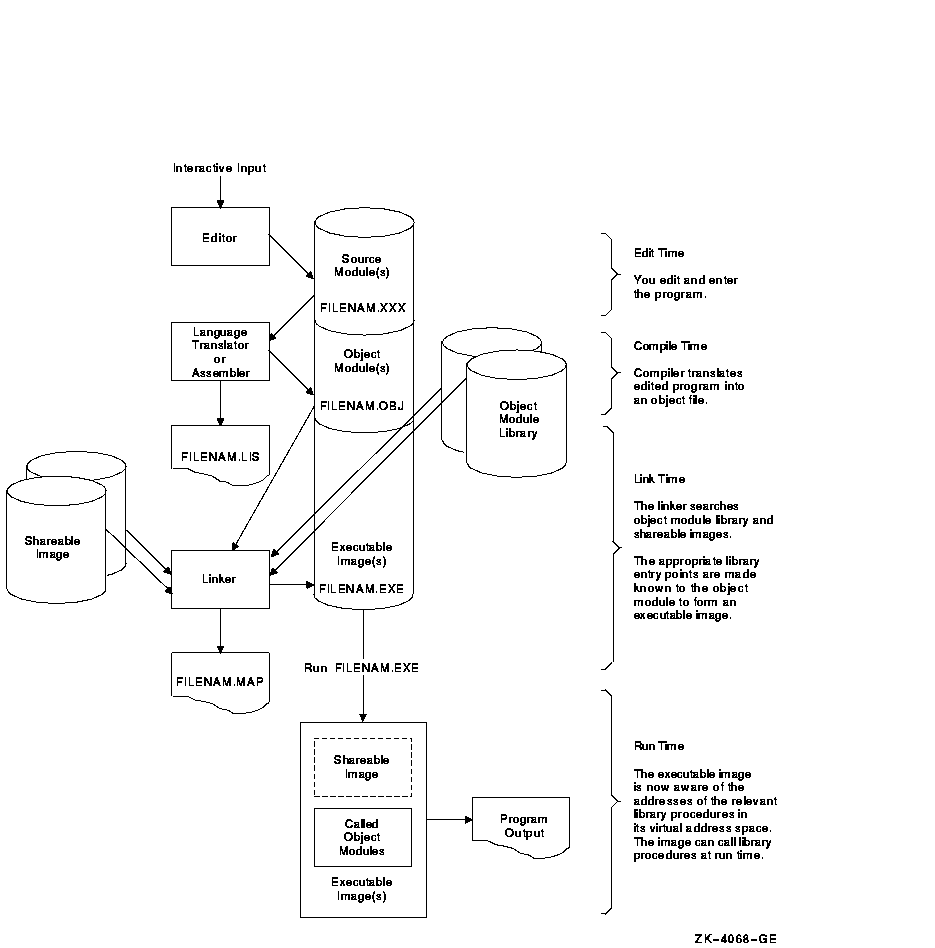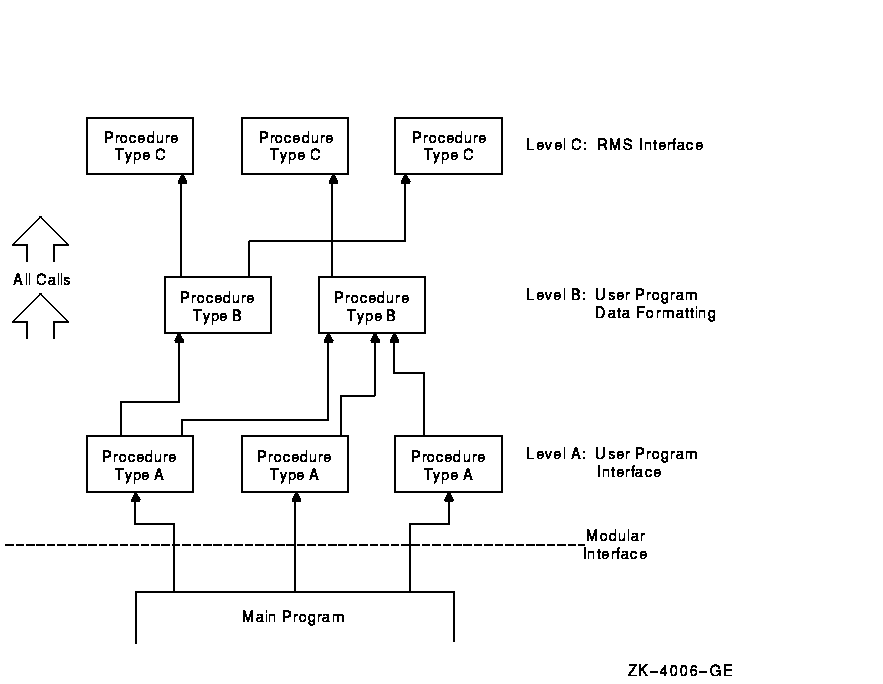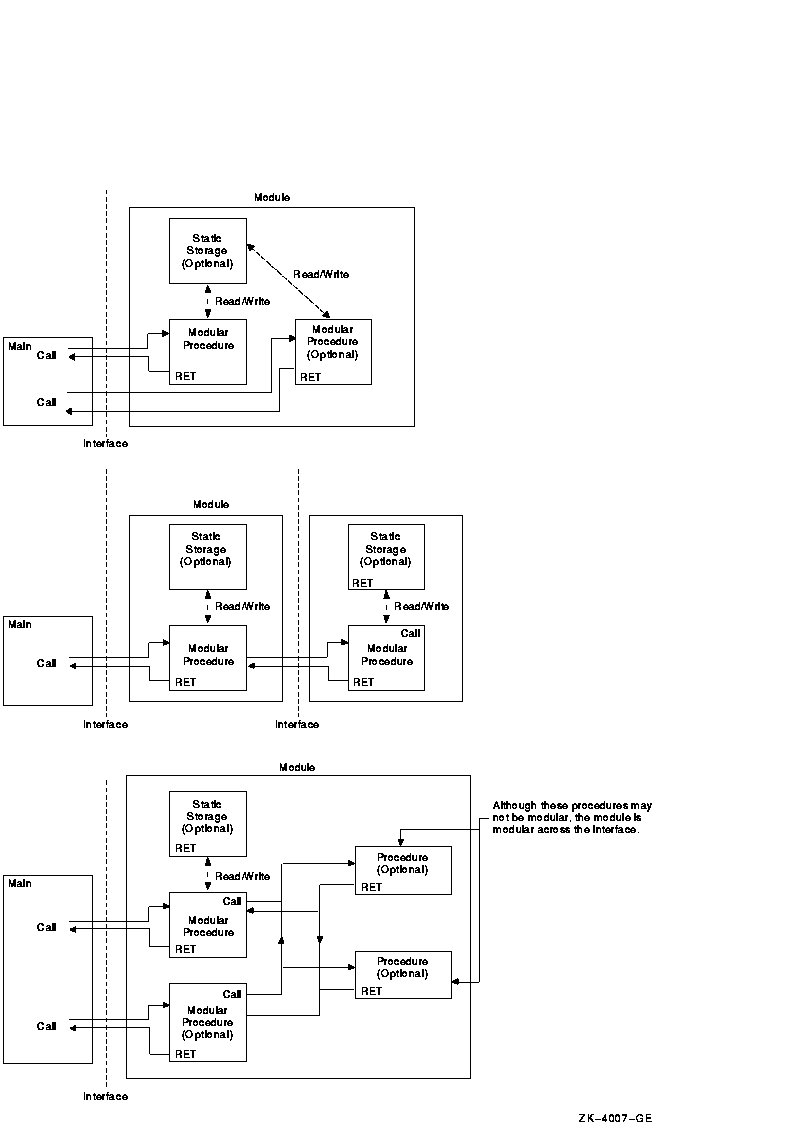![[Compaq]](../../images/compaq.gif)
![[Go to the documentation home page]](../../images/buttons/bn_site_home.gif)
![[How to order documentation]](../../images/buttons/bn_order_docs.gif)
![[Help on this site]](../../images/buttons/bn_site_help.gif)
![[How to contact us]](../../images/buttons/bn_comments.gif)
![[OpenVMS documentation]](../../images/ovmsdoc_sec_head.gif)
| Document revision date: 19 July 1999 | |
![[Compaq]](../../images/compaq.gif) |
![[Go to the documentation home page]](../../images/buttons/bn_site_home.gif)
![[How to order documentation]](../../images/buttons/bn_order_docs.gif)
![[Help on this site]](../../images/buttons/bn_site_help.gif)
![[How to contact us]](../../images/buttons/bn_comments.gif)
|
![[OpenVMS documentation]](../../images/ovmsdoc_sec_head.gif)
|
|
Order Number: AA--PV6AC--TK
This manual describes how to create a complex application program by dividing it into modules and coding each module as a separate procedure.
Revision/Update Information: This manual supersedes the Guide to Creating OpenVMS Modular Procedures, Version 1.0.
Software Version:
OpenVMS Alpha Version 7.1
OpenVMS VAX Version 7.1
The content of this document has not changed since OpenVMS Version 7.1.
Compaq Computer Corporation Houston, Texas
Compaq Computer Corporation makes no representations that the use of its products in the manner described in this publication will not infringe on existing or future patent rights, nor do the descriptions contained in this publication imply the granting of licenses to make, use, or sell equipment or software in accordance with the description.
Possession, use, or copying of the software described in this publication is authorized only pursuant to a valid written license from Compaq or an authorized sublicensor.
Compaq conducts its business in a manner that conserves the environment and protects the safety and health of its employees, customers, and the community.
© Compaq Computer Corporation 1999. All rights reserved.
The following are trademarks of Compaq Computer Corporation: Alpha, Compaq, DEC Ada, DECdirect, DEC Fortran, DECmigrate, DECthreads, DECwindows, DIGITAL, OpenVMS, VAX, VAX BASIC, VAX C, VAX DOCUMENT, VAX FORTRAN, VAX MACRO, VAX Pascal, VAXcluster, VMS, and the Compaq logo.
The following is a third-party trademark:
Motif is a registered trademark of the Open Software Foundation.
All other trademarks and registered trademarks are the property of their respective holders.
ZK4518
The OpenVMS documentation set is available on CD-ROM.
| Contents | Index |
This manual contains guidelines for developing, integrating, and maintaining modular procedures. It is intended for advanced system and applications programmers who are already familiar with OpenVMS operating system concepts. Readers should also be proficient in at least one supported language.
This book contains the following chapters and appendix:
The following manuals provide additional details and the most current information about the programming tasks described in this book:
For additional information on the Open Systems Software Group (OSSG) products and services, access the following OpenVMS World Wide Web site address:
http://www.openvms.digital.com |
Compaq welcomes your comments on this manual.
Print or edit the online form SYS$HELP:OPENVMSDOC_COMMENTS.TXT and send us your comments by:
| Internet | openvmsdoc@zko.mts.dec.com |
| Fax | 603 884-0120, Attention: OSSG Documentation, ZKO3-4/U08 |
|
Compaq Computer Corporation
OSSG Documentation Group, ZKO3-4/U08 110 Spit Brook Rd. Nashua, NH 03062-2698 |
Use the following World Wide Web address to order additional documentation:
http://www.openvms.digital.com:81/ |
If you need help deciding which documentation best meets your needs, call 800-344-4825.
The following conventions are used in this manual:
| Ctrl/ x | A sequence such as Ctrl/ x indicates that you must hold down the key labeled Ctrl while you press another key or a pointing device button. |
| PF1 x | A sequence such as PF1 x indicates that you must first press and release the key labeled PF1 and then press and release another key or a pointing device button. |
| [Return] | In examples, a key name enclosed in a box indicates that you press a key on the keyboard. (In text, a key name is not enclosed in a box.) |
| ... |
Horizontal ellipsis points in examples indicate one of the following
possibilities:
|
|
.
. . |
Vertical ellipsis points indicate the omission of items from a code example or command format; the items are omitted because they are not important to the topic being discussed. |
| ( ) | In command format descriptions, parentheses indicate that, if you choose more than one option, you must enclose the choices in parentheses. |
| [ ] | In command format descriptions, brackets indicate optional elements. You can choose one, none, or all of the options. (Brackets are not optional, however, in the syntax of a directory name in an OpenVMS file specification or in the syntax of a substring specification in an assignment statement.) |
| [|] | In command format descriptions, vertical bars separating items inside brackets indicate that you choose one, none, or more than one of the options. |
| { } | In command format descriptions, braces indicate a required choice of options; you must choose one of the options listed. |
| bold text | This text style represents the introduction of a new term or the name of an argument, an attribute, or a reason. |
| italic text | Italic text indicates important information, complete titles of manuals, or variables. Variables include information that varies in system output (Internal error number), in command lines (/PRODUCER= name), and in command parameters in text (where device-name contains up to five alphanumeric characters). |
| UPPERCASE TEXT | Uppercase text indicates a command, the name of a routine, the name of a file, or the abbreviation for a system privilege. |
| Monospace text |
Monospace type indicates code examples and interactive screen displays.
In the C programming language, monospace type in text identifies the following elements: keywords, the names of independently compiled external functions and files, syntax summaries, and references to variables or identifiers introduced in an example. |
| - | A hyphen at the end of a command format description, command line, or code line indicates that the command or statement continues on the following line. |
| numbers | All numbers in text are assumed to be decimal unless otherwise noted. Nondecimal radixes---binary, octal, or hexadecimal---are explicitly indicated. |
A procedure is a set of related instructions that performs a task. A module is a single body of code and text that can be assembled and compiled as a unit.
A procedure is modular if it contains all the definitions and calls it needs to perform a task. A modular procedure must also follow rules and principles that permit it to be successfully linked with other procedures that follow the same rules and principles.
This chapter briefly discusses:
Procedures can be combined to form programs in the following ways:
For procedures to execute successfully when they are combined to form a program, they must follow general guidelines. Modular procedures that do not follow these guidelines can cause other procedures in the program image to execute incorrectly.
The modular programming guidelines in this manual are designed to give programmers a common environment in which to write code. If all programmers follow these guidelines, then any modular procedure can be added to a procedure library without conflicting with procedures already in the library or with any that are added later.
Modular programming offers the following advantages:
Many of the guidelines in this manual are recommendations, not requirements. By following all the guidelines, however, you can realize the following additional advantages:
Typically, you invoke a procedure by executing a VAX CALLS or CALLG instruction (on VAX systems) or JSR instruction (on Alpha systems). If you are using a high-level language, the compiler generates the appropriate transfer instruction when you use the conventions required by your language to implement a procedure.
For more information about calling sequences, refer to OpenVMS Programming Interfaces: Calling a System Routine. To
find out how specific languages implement procedures, refer to the
documentation set for your language processor.
1.3 Using Procedure Libraries
You can use modular procedures for general programming, or you can group them in procedure libraries. Grouping procedures into libraries is a way of collecting procedures so that calling programs can access them easily. When you link your program to a library, the OpenVMS Linker utility (linker) automatically searches that library to resolve any references that your program makes to procedures in the library. Because the linker searches the specified library automatically, your program can call many modular procedures without including the name of each procedure explicitly in the LINK command. The program's executable image and the procedures that it calls are executed in the proper sequence at run time.
Figure 1-1 shows the development of a program that calls one or more procedures in a library. Depending on the options you select when writing modular procedures, you can control the way the linker accesses your procedures, and therefore, the way procedures are invoked at run time. For example, if you place commonly used procedures within a shareable procedure library or shareable image library, you can save memory and disk space because all user processes can access a single copy of the shared procedures.
Figure 1-1 Developing a Program That Calls Library Procedures

The OpenVMS operating system includes many system routines that perform advanced applications. These procedures are designed to perform various general functions and can be useful building blocks for your own procedures. Before you write a new procedure, make sure the application does not already exist. You should call an existing procedure from a system library whenever possible, instead of duplicating code.
The following types of callable system procedures are available as part of the OpenVMS operating system:
For more information about how to use callable system procedures, refer
to OpenVMS Programming Concepts Manual.
1.5 Using Translated Images (Alpha Only)
Programs that run on VAX systems can be converted to run on Alpha systems by recompiling and relinking or by translating. A single application can include both native images (those that were recompiled and relinked) and translated images.
The most effective way to convert a program that runs on a VAX system to one that runs on an Alpha system is to recompile the source code using a native Alpha compiler, and then to relink the object files and shareable images using the linker.
The alternative method, translation, involves using DECmigrate for OpenVMS Alpha, which supports the migration of VAX applications to Alpha applications by translating images. DECmigrate converts VAX images into functionally equivalent images that can run on Alpha systems. DECmigrate includes the VAX Environment Software Translator (VEST) utility, which analyzes a VAX executable or shareable image and creates a functionally equivalent translated image.
The Translated Image Environment (TIE), which is part of the OpenVMS Alpha operating system, provides the run-time support for translated images on OpenVMS Alpha. The TIE includes an Alpha shareable image that provides each translated image with an environment similar to OpenVMS VAX, interprets untranslated VAX instructions, and processes all interactions with the native Alpha system. The TIE also includes a translated image that executes complex VAX instructions.
For more information about VEST and TIE, refer to DECmigrate for OpenVMS AXP Systems Translating Images. For more information about mixing native Alpha and translated VAX modules in a single application, see Migrating an Application from OpenVMS VAX to OpenVMS Alpha.
Well-designed procedures are more likely to be modular, well-written, and easy to maintain. Any time that you save by skimping at the design stage will be lost as you fix problems stemming from a poor design.
This chapter discusses the following aspects of designing a new application:
Before designing a new application, look at the overall organization.
An application should be made up of one or more files, each containing
one or more procedures. When linked, the procedures are organized into
program sections (PSECTs). Each procedure, as well as the interface
between the procedures, should conform to the modular guidelines
described in this manual.
2.1.1 Organizing Files and Modules
Each application contains one or more files. Each file contains exactly
one module. For information about naming files, refer to Section 3.1.1.3.
For information about naming modules, refer to Section 3.1.1.4.
2.1.2 Organizing Procedures into Modules
Each module should contain a single procedure or a group of related procedures. The linker always brings the entire module containing a called procedure into the image if any of its entry points are referenced. Therefore, placing each procedure in a separate module reduces image size and allows more flexibility when using a procedure library. You can supply your own version of one procedure while using other procedures from the library. If many procedures have been grouped in a single module, the linker must link all or none of them.
Group procedures into a module if they share the same static storage or if they have a similar calling sequence, perform similar functions, and share a significant amount of code.
If you are writing a large number of related procedures that call one another or access common data blocks, make the relationship among those procedures as clear as possible. To do this, use the following guidelines to minimize the interaction between procedures, and between procedures and data structures:
Figure 2-1 shows the BASIC and FORTRAN record I/O processing procedures, which are implemented in the following three levels of abstraction:
Figure 2-1 Levels of Abstraction

All calls are made in one direction, to the next innermost level. Procedures at different levels should be in different modules. Figure 2-2 shows possible groupings of procedures.
Figure 2-2 Possible Procedure Groupings

Procedures communicate with one another by passing arguments. To
clarify the interactions between procedures and programs, you must
define each argument when you are designing a procedure. There are two
types of arguments: explicit arguments and implicit arguments. The
following sections define explicit and implicit arguments and describe
how to use them.
2.2.1 Explicit Arguments
Explicit arguments are a procedure's primary interface with other programs. Therefore, to maintain a modular interface, you must follow the rules for argument order, data types, and passing mechanisms. The following format is used to describe each argument:
argument-name OpenVMS usage: argument-data-structure type: argument-data-type access: argument-access mechanism: argument-passing-mechanism |
For descriptions of each of these four argument attributes, see the OpenVMS Programming Interfaces: Calling a System Routine.
To make your procedures easier to call, be sure that the passing
mechanism used for particular data types is consistent throughout all
procedures in a facility. Passing all atomic data by reference and all
string data by descriptor is recommended.
2.2.2 Implicit Arguments
An implicit argument is one that is not specified in the argument list. Implicit arguments provide additional information to your procedure from static storage locations. Two types of implicit arguments are:
Using implicit arguments is discouraged because they make the
relationship across procedures less clear and tend to increase the
interaction between procedures in a way that might go undetected. If
your procedure must retain information from previous activations, see
Section 2.2.3 for ways to avoid using implicit arguments.
2.2.2.1 Implicit Arguments Allocated by the Calling Program
The calling program can allocate implicit arguments as statically allocated variables in a named PSECT (for example, COMMON and MAP in BASIC, COMMON in FORTRAN, or variables declared in the outer block of a procedure or program in Pascal). The calling program can also allocate implicit arguments as statically allocated global variables (for example, symbols defined with a double colon [::] in MACRO and GLOBAL variables in BLISS).
Allocation of implicit arguments by the calling program is not recommended for the following reasons:
| Next | Contents | Index |
![[Go to the documentation home page]](../../images/buttons/bn_site_home.gif)
![[How to order documentation]](../../images/buttons/bn_order_docs.gif)
![[Help on this site]](../../images/buttons/bn_site_help.gif)
![[How to contact us]](../../images/buttons/bn_comments.gif)
|
| privacy and legal statement | ||
| 4518PRO.HTML | ||